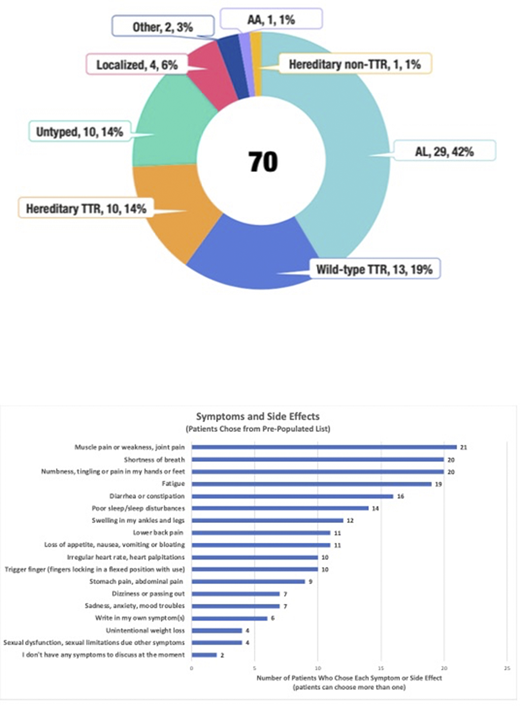Systemic amyloidoses are a group of progressive and life-threatening rare diseases. Patients often feel overwhelmed by the complexities of symptoms, treatment options, and management of their care team. The Amyloidosis Appointment Companion (AAC) was created to help patients identify their goals of care, changes in their condition, as well as the challenges they are facing and share these with their health care providers (HCPs). The AAC has been developed to create a synergy between patients and their clinicians as it relates to not only their health and wellbeing but their overall life goals, and to guide discussion and development of their treatment plan.
Here we report on the findings of the first 70 patients to use the AAC at the Amyloidosis Center of Boston University Medical Center (BUMC).
The Amyloidosis Research Consortium (ARC) in collaboration with Patient Discovery, a virtual healthcare platform, created the AAC, a digital tool to guide patients through a personalized, interactive survey in order to capture their current status, treatment goals and preferences, correct misperceptions, frame decisions, and promote adherence to treatment plans. The tool was beta tested at 5 amyloidosis centers to assess dissemination and clinical integration strategies, decision-making processes, and communication. The tool launched at BUMC in January 2020, after being integrated into the appointment process as part of both in person and virtual telehealth visits via the Amyloid Center Office and included in the appointment scheduling workflow. Data collected via the tool is securely shared with BUMC by patients and entered into their charts. Additional telehealth-specific features were added to the AAC when the BUMC clinic added virtual appointments in response to COVID-19.
This is a report of the findings from the first 70 patients utilizing the tool over a five-month time period. There was a completion rate of 82%, well above the industry standard for patient surveys of 41%. The average user age was 65 years (range, 24 to 86), and 41% (n=29) of patients used the AAC on a mobile device.
Patients reported the following subtypes of amyloidosis:
Patients spent an average of 16.5 minutes using the AAC prior to their appointment and completed the following tasks:
Completing Clinic Intake Forms
Preparing for Telehealth Appointments
Reconciling Medications
Capturing Treatment Satisfaction and Preferences
Sharing Goals of Care
Reporting Symptoms and Side Effects
Charting Labs
Reviewing Educational Videos
Reporting on Quality of Life Measures
Of these 70 patients, 60% (n=42) patients reported slight to moderate levels of anxiety or depression and 69% (n=48) pain and 59% (n=41) restricted mobility. Two main types of reported goals of care were identified: 1) short term, isolated goals (such as attending a specific life event) and 2) long term, lifestyle goals (such as regaining exercise tolerance or living independently).
Individualized to their responses, patients prioritized a list of topics to discuss with their clinicians, the most common topics were: 1. Understanding treatment options, 2. Learning more about my disease, 3. Managing my symptoms and side effects, 4. Concern my disease is progressing.
Three providers within the Amyloidosis Center at BUMC independently reported enhanced satisfaction with outcome of appointments as a result of patients having used the AAC. The data patients shared led to greater efficiency during telehealth appointments in particular with the time saved on medicine reconciliation and vital signs, allowing more time during the appointment to focus on delivering personalized care.
The AAC demonstrated improved patient to physician communication particularly during a time of increased telehealth visits. The AAC is a patient and provider centered tool that facilitates patient communication and involvement in decision making, as well as helping providers understand their patients' preferences and goals of care. The tool improves appointment efficiency in particular, reducing significantly the time taken up in a telehealth visit for medication reconciliation, obtaining vitals and in some cases, technical support. The tool emphasizes patient engagement to improve patient-provider communication. Furthermore, insights from these data provide powerful information that may help improve development of assistance programs, clinical trials, and research.
Shore:Patient Discovery Solutions, Inc.: Current Employment, Current equity holder in private company. Sodowick:Patient Discovery Solutions, Inc.: Current Employment, Current equity holder in private company. Mendelson:Patient Discovery Solutions: Consultancy. Sanchorawala:Proclara: Other: advisory board; Caleum: Other: advisory board; Regeneron: Other: advisory board; Oncopeptide: Research Funding; Caelum: Research Funding; Prothena: Research Funding; Celgene: Research Funding; Takeda: Research Funding; Janssen: Research Funding; Abbvie: Other: advisory board; UpToDate: Patents & Royalties.
Author notes
Asterisk with author names denotes non-ASH members.


